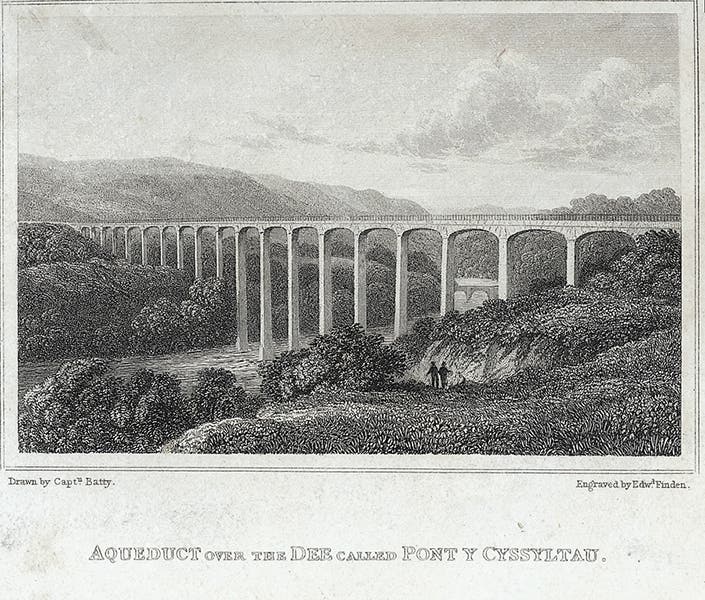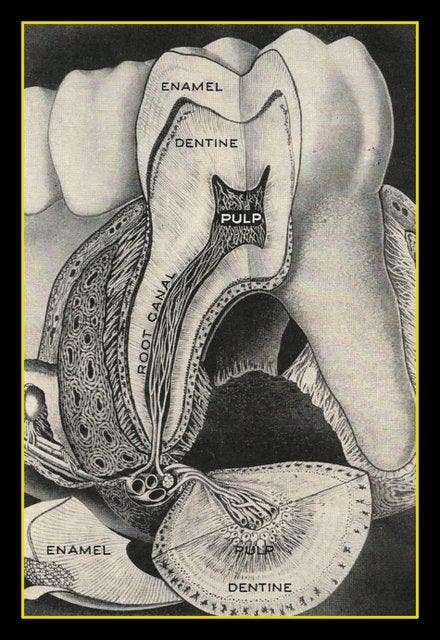Scientist of the Day - Eleazar Root
Eleazar Root, a British civil engineer, was born Apr. 1, 1805. Root grew up in West Riding, in Yorkshire. In the 1830s, he set up a company specializing in applying waterproof linings to canal beds, which at the time meant mastering the whimsies of puddling clay. Then, in 1849, there was a serious crisis that attracted the attention of all canal engineers – the Pontcysyllte Aqueduct was leaking badly. The aqueduct, which carries the Llangollen Canal over the River Dee in northeastern Wales, had been built in 1805 by Thomas Telford and William Jessop. It was not the first navigable aqueduct, but it was certainly the prettiest, and also the loftiest, as some of the piers rose 115 feet above the valley floor (second image). The aerial canal, which could carry, albeit snugly, traditional 70-foot narrowboats across the river, was a 1000-foot-long cast-iron trough, built in 52-foot sections, and therein lay the problem. The joints had been sealed with tar (and Welsh flannel), and the tar had dried and cracked; although patched and repatched, the leaking grew worse, and water was now literally gushing down the piers. It was hard to keep enough water in the trough to float the boats, and the aqueduct had to be closed, awaiting a solution.
Root's firm was called in to consult on the problem. Clearly a new sealant was needed. Root had friends in the electrical engineering industry, and he knew of a new substance that was proving useful for submarine telegraph cables – gutta-percha. The sap of a tree, gutta-percha came from southeast Asia; it was like rubber, but better, because it remained flexible under all conditions. It made a perfect insulator for submarine cables because it did not break down, even under adverse conditions. Root wondered whether gutta-percha might find use as a canal sealant. He experimented on several abandoned aqueduct troughs and found that it worked well. He was given permission to try his gutta-percha sealant on the Pontcysyllte Aqueuct, and it worked like a charm. The canal was navigable again.
Root became a minor public celebrity in Victorian England when the Illustrated London News ran a story about how he saved the Pontcysyllte Aqueduct. His portrait was sketched by the inimitable Thomas Maguire, putting Root in the company of Charles Darwin, Michael Faraday, and Richard Owen (first image). Root decided to capitalize on his temporary fame by marketing his sealant for general purpose use. After all, it would seal just about anything. He came out with a product called Eleazar Root's Canal Sealant, which he offered for sale to the general public, much as we sell Elmer’s Glue today. The label on the jars featured the Pontcysyllte Aqueduct, and he retained the term "Canal Sealant" to remind the buyer that this was the goop that saved the famous Welsh aqueduct. He did not mention that it was just ordinary gutta-percha, which one could buy from a jobber for a fraction of the price.
His sealant sold well, if not spectacularly, until Root quite by chance stumbled into the most successful application of his product. He was visiting his dentist, who was lamenting the fact that a new and promising form of dentistry was languishing for want of a sealant. With the discovery of anesthesia in 1846, it became possible in the 1850s to perform a variety of dental surgeries, including removing the exposed nerves of diseased teeth. But a material was needed to seal off the nerve endings. Root ventured to suggest that his Canal Sealant might do the job, and he was right. It stayed flexible; it was an excellent insulator and did not react with nerve endings; it was tough and resilient to food and saliva. Its use spread rapidly. Dentists referred to this new procedure as the Eleazar Root Canal Sealant technique, which was soon shortened to the Root Canal Sealant process. The area where the sealant was applied came to be called the Root canal. Henry Vandyke Carter used that name when he labelled his illustration of tooth structure for the first edition of Henry Gray's Anatomy in 1858.
Unfortunately for Root, two things happened. First, dentists discovered that they could use ordinary gutta percha, which was much cheaper, instead of the pricey Eleazar Root's Canal Sealant, and they quit buying it. Second, the next generation of dentists assumed that the "root" of "Root canal" referred to the root of the tooth, not the Root of West Riding, and Root's connection with Root canal surgery was lost. By the time of his death in 1867, his name was already forgotten.
The introduction of gutta percha into dentistry was a most significant innovation – really the founding moment of endodontics – and it is sad that Root's role has been completely forgotten. Nor does anyone remember that he gave new life to the Pontcysyllte Aqueduct, which, we might note, is still standing and functional, thanks to Root. He deserves our recognition and thanks, on this first day of April, 2020.
We appreciate the help of Melissa Dehner, graphic designer, with this post.
Dr. William B. Ashworth, Jr., Consultant for the History of Science, Linda Hall Library and Associate Professor emeritus, Department of History, University of Missouri-Kansas City. Comments or corrections are welcome; please direct to ashworthw@umkc.edu.










